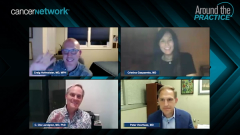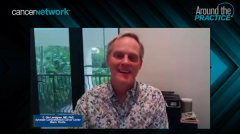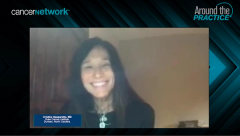
Future Directions in Multiple Myeloma Care: Improvements and Unmet Needs
After reviewing implications of the MAIA study in multiple myeloma, experts consider unmet needs and future directions in care.
Episodes in this series

Transcript:
C. Ola Landgren, MD, PhD:If you think about the MAIA results, let’s try to expand our thinking the last 10 minutes. There are a couple of trials that have influenced the field a lot that have tie-in to this. There are 2 trials I’m thinking of. One is the FIRST trial. That to me is a non-US trial, sort of. It’s more like an ex-United States, like continuous therapy vs fixed duration. It showed that continued Revlimid-dexamethasone had a better outcome than fixed duration. In the United States, we probably wouldn’t stop therapy so much. But then you have also the SWOG trial that you talked about, 0777, which compared VRd [bortezomib, lenalidomide, dexamethasone] to Rd [lenalidomide, dexamethasone]. Not surprisingly, VRd [bortezomib, lenalidomide, dexamethasone] was better than Rd [lenalidomide, dexamethasone]. If you add 1 more drug, and if it works, it probably would become the winner. That’s what that study showed. How does this MAIA trial, which we heard in June has such a great PFS [progression-free survival] and also OS [overall survival]? How does that fit into the field as an extension? Is this challenging the VRd [bortezomib, lenalidomide, dexamethasone]? Is it taking over as continued Rd [lenalidomide, dexamethasone]? What’s your thinking, Peter?
Peter Voorhees, MD: At EHA [European Hematology Association Congress], Dr [Thierry] Facon updated the PFS. At 5 years, DRd [daratumumab, lenalidomide, dexamethasone] progression-free survival was 52.5%, so they hadn’t even hit their median PFS yet, whereas the Rd [lenalidomide, dexamethasone] median PFS had been hit many months prior. They’d previously shown that progression-free survival, too, is superior with DRd [daratumumab, lenalidomide, dexamethasone], suggesting that you’re not breeding more resistant disease at the time of relapse, which is important. Most importantly, at the EHA meeting, they showed a statistically—and I’d argue very clinically—significant improvement in overall survival as well. The hazard ratio was 0.68 or something like that, so a 32% or so reduction in risk of death with the addition of daratumumab to the lenalidomide-dexamethasone backbone. There’s no neuropathy with daratumumab, which is a big plus for patients. You’re going to see this used more in patients with newly diagnosed, transplant-ineligible myeloma. But there are trade-offs, so far and away less neuropathy, but you’re going to have more severe neutropenia with the daratumumab-lenalidomide-dexamethasone combo compared with RVd [lenalidomide, bortezomib, dexamethasone] or RVd [lenalidomide, bortezomib, dexamethasone]–lite, and you’re probably going to see some more infection risk there as well. There’s a bit of a trade-off, and you have to be very vigilant about monitoring these patients and making sure they speak up as soon as they develop symptoms of that respiratory tract infection so you can get them triaged and treated appropriately.
C. Ola Landgren, MD, PhD:Because daratumumab binds to CD38, which is expressed on both myeloma cells and normal plasma cells, we see that patients receiving daratumumab drop in their regular immunoglobulin G, so they can become hypogammaglobulinemia. You talk about the infection risk, and also you could see drops in white blood cell count. Cristina, do you typically give IVig [intravenous immunoglobulins] for all the patients, or the patients who drop in numbers? Do they have to develop infections, or do you have a strategy for that?
Cristina Gasparetto, MD: I’ve been trying to do that for patients with IgG level less than 400 mg/dL. Unfortunately, it’s not that easy. Sometimes we don’t get insurance approval. You need to justify. You need to show that your patient had at least a couple of infections over a short span of time. I try. We do that regularly in our transplant patients, immunocompromised throughout the allogeneic, so why not? In this population we’re proving that we definitely affect immune system. We saw that very well with COVID-19, unfortunately. Thus, I try.
C. Ola Landgren, MD, PhD:Craig, we’re about to wrap up. What are the ongoing unmet needs for patients who are transplant ineligible in myeloma?
Craig Hofmeister, MD, MPH: Wow. That’s a large list of things that we need to discuss, Ola. Let’s get down to it. No. 1, we need to have better prediction for patients who will develop disabling neuropathy, which is the horrible end result for many patients who are inducted with bortezomib. And we need to find therapy that’s cheaper and much more effective, because $100,000 a year is a terrible financial burden for the entire system. That’s why I’m so excited for ideally newer and more effective older treatments that improve effectiveness. Those are the 2 things that come to mind, but there’s a long list.
C. Ola Landgren, MD, PhD:Yeah, there’s a long list. I said we have only 5 minutes left, but then I dropped that bomb on you. That was a tough 1, but you did pretty well. Now, we have 1 more minute for Peter. How do you expect the treatment landscape to evolve for the coming 5, 10 years, Peter? One minute.
Peter Voorhees, MD: We’re going to move away from treatment until disease progression to defined duration of treatment. We’ll probably have the opportunity to use MRD [minimal residual disease] testing to make that happen. You’re going to see the bispecifics [antibodies] and CAR [chimeric antigen receptor] T cells move to the front line to achieve that goal.
C. Ola Landgren, MD, PhD:Cristina, where do you see the future going in the coming 5, 10 years? Do you think we’ll have chemotherapy-free treatments? Will it be all antibodies for everybody? Will there be no PIs [protease inhibitors] and no IMiDs [immunomodulatory imide drugs]? Or do you think we’ll have those drugs around for a while?
Cristina Gasparetto, MD: We’ll still have drugs around this. I hope that we’re going to be able to individualize therapy. Rather than treat all patients the same way, treat them based on their myeloma characteristic. I hope we can understand more about the biology of the disease so we can choose the right combination for the patient rather than the same for everybody. My hope is that in the future we can individualize therapy, like with the 11;14 with the venetoclax incorporated in some of the regimens. Hopefully we can do the same for some of these patients with very high-risk myeloma, as we were discussing earlier, or the more standard-risk patients. Myeloma is high risk by definition, so you have to treat it aggressively. But the combination that you choose might be different.
C. Ola Landgren, MD, PhD:We have only 1 minute left. I agree with everything you said. I’ll be a little bold to end the conversation and say that for a lot of the things we do today, 10 years from now, most of those things will probably have changed. We’ll have antibodies in every line, and I’ll bet that some patients probably could do antibody-only therapy, just to be a little provocative. I also think that blood-based MRD testing will guide therapy in the future. There’s a lot of work that needs to be done, but there will be a lot of change. We already have therapies, in my opinion, that could make some patients diagnosed in 2021 to live with the same life span as a person with the same age and gender who does not have myeloma. Because the current drugs can make patients live so long. During such a long window, there will be many new drugs, so we’re already at the tipping point. Not for every patient but for some patients. That’s what I think.
Cristina Gasparetto, MD: I agree.
C. Ola Landgren, MD, PhD:With that, I’d like to thank Dr Gasparetto, Dr Hofmeister, and Dr Voorhees for joining this lively discussion on patients with transplant-ineligible myeloma, brought to you by CancerNetwork®. Thank you so much to the viewing audience. We hope you found this interactive discussion to be informative and beneficial to your clinical practice. Thank you very much.
Transcript edited for clarity.
Newsletter
Stay up to date on recent advances in the multidisciplinary approach to cancer.





















































































